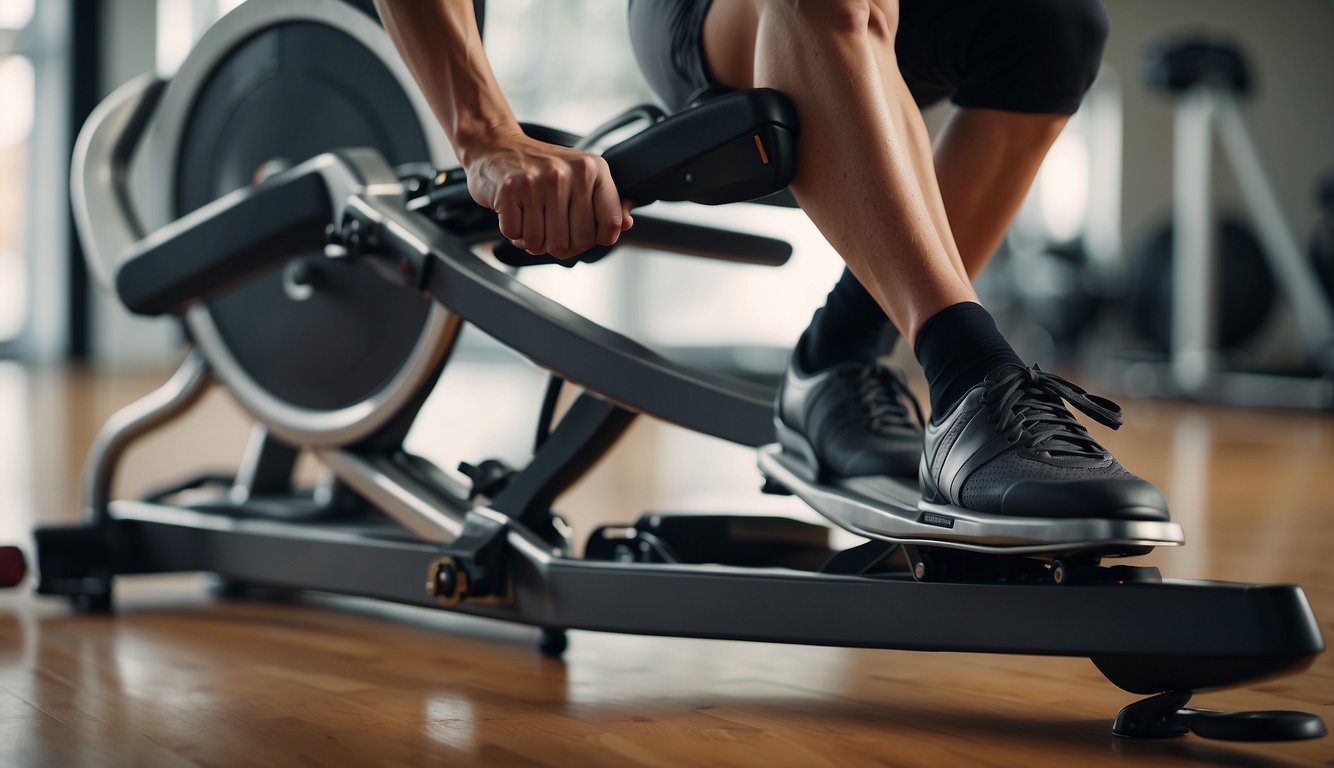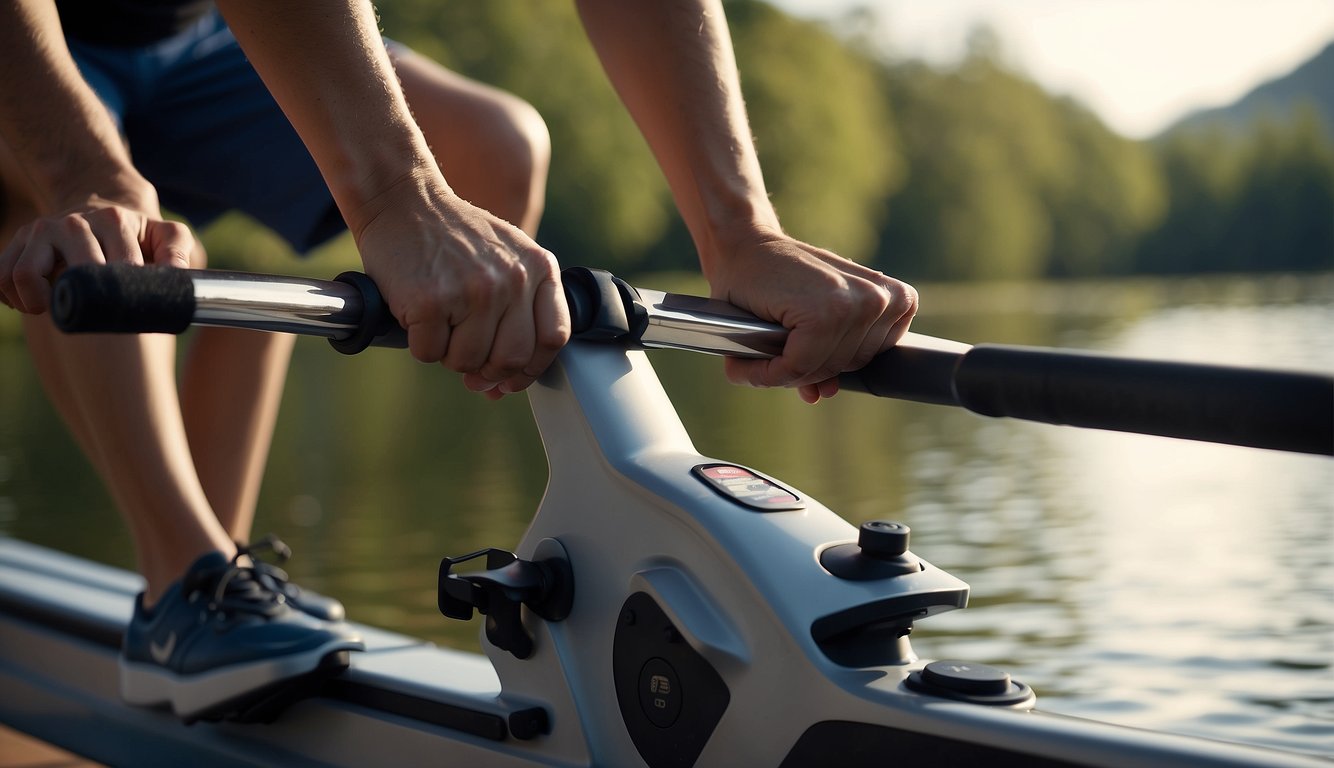Mastering the correct technique on a rowing machine can transform the effectiveness of your workouts. The rowing machine is a comprehensive piece of fitness equipment that, when used properly, can provide an efficient, full-body workout.
It's essential to understand the importance of maintaining proper form throughout your rowing session, as this not only maximises the workout's benefits but also minimises the risk of injury.

A proper rowing stroke is divided into two main parts: the drive and the recovery. Your posture, the sequence in which you engage your muscles, and the rhythm of your stroke all play critical roles in your performance.
By focusing on the fundamentals of rowing machine technique, which involve the coordination of legs, core, and arms, we can optimise performance and endurance. Additionally, understanding the common mistakes to avoid can help in preventing injuries, allowing for a more enjoyable and safer rowing experience.
Key Takeaways
- Effective rowing technique enhances workout efficiency and safety.
- Sequential muscle engagement and correct posture are vital.
- Avoiding common mistakes reduces the risk of injury.
Fundamentals of Rowing Machine Technique

In mastering the rowing machine, it's crucial to understand the rowing stroke cycle and maintain correct posture. Our technique directly impacts effectiveness and reduces the risk of injury.
Understanding the Stroke Cycle
The rowing stroke cycle comprises four phases: the catch, the drive, the finish (or release), and the recovery. At the catch, our shins are vertical, heels planted, and body leaning forward from the hips with arms extended. It's the moment before we exert force.
The drive is initiated with a powerful leg push, transitioning force through our engaged core as our back leverages past vertical and we draw the handle to our torso. The finish occurs when legs are fully extended, back is slightly reclined, and elbows pass the body with the handle at chest height.
Entering the recovery phase, we reverse the sequence: arms extend, the body leans forward from the hips, and legs bend returning us smoothly to the catch position.
Correct Posture and Seat Position
Our posture while rowing safeguards against strain and maximises power transfer. A crucial part begins with seat position— ensuring the seat allows a full leg extension without locking the knees and provides enough room for the body to lean forward and back.
During each stroke, we maintain a strong, straight back, avoiding rounding or overarching. A firm core stabilises the torso as we pivot from the hips. Throughout the stroke, our arms remain relaxed until the final pulling phase, with wrists flat.
Proper form means engaging the legs first, the majority of the force comes from these muscles, and as the legs reach about half extension, we start to hinge back at the hips before finally drawing the handle in with the arms. By securing our heels against the footrests, we can push off more powerfully with each stroke.
Mastering the Stroke Phases
When utilising the rowing machine, mastering each phase of the stroke is vital to maximising the efficacy of your workout and minimising injury risk. We'll break down the stroke into its four key components: the catch, the drive, the finish, and the recovery, ensuring you maintain correct form throughout.
The Catch
In the catch phase, it's all about the initial position. We begin with our knees bent, shins vertical, and body leaning slightly forward at the hips, arms extended. It's critical to ensure that our core is engaged and we are positioned at the front of the rowing machine, ready to initiate the drive.
The Drive
The drive phase is where we harness power primarily from our legs, transitioning to our back and shoulders. We commence pushing with our legs, keeping our back straight and core tight, then once our legs are extended, we pivot back through the hips and pull the handle towards our lower ribs using our arms.
The Finish
Reaching the finish, we are at the most rearward phase of the stroke. Our legs are extended, our shoulders slightly back, and the handle is held at our ribs. It's imperative to keep our elbows flexed and shoulders relaxed, not allowing them to hunch up.
The Recovery
Finally, in the recovery phase, we ease the movement by extending our arms first, then leaning the torso forward from the hips, followed by the gradual bending of our knees. This controlled sequence leads us smoothly back into the catch phase, preparing us for the next stroke.
Optimising Rowing Performance
To enhance our rowing performance on a machine, it's vital to focus on developing both strength and endurance, understanding the cardiovascular benefits, and utilising the exercise as a whole-body workout. We'll address the specific ways to maximise these aspects of rowing.
Building Endurance and Strength
Building endurance and strength is essential for increasing our time on the rowing machine and the power of each stroke. We start by setting a consistent workout schedule, ensuring we're challenging our muscles while allowing for recovery time.
Our workouts should include intervals with varying resistance levels to progressively build muscular endurance. Workouts with higher resistance will engage more muscle groups, leading to stronger strokes.
Cardiovascular Benefits of Rowing
Rowing is an excellent cardio workout that can elevate our heart rate and improve cardiovascular health. By maintaining a consistent pace and keeping our timing in check, we can ensure that we're engaging our heart and lungs effectively. Alternating between high-intensity bursts and moderate, steady periods can boost our overall heart rate performance during the workout.
Whole-Body Workout
Rowing engages numerous muscle groups, offering us a comprehensive whole-body workout. It targets our legs, core, and arms, providing a balanced fitness routine. To ensure we're engaging all these muscle groups effectively, we must pay close attention to our stroke—maintaining proper form throughout.
Proper form means a strong leg drive, a firm core to connect the lower and upper body, and a powerful arm pull through to the finish.
Preventing Common Rowing Injuries
In our quest for fitness, we are often eager to power through our workouts, but when it comes to using a rowing machine, taking precautions against injuries is crucial. We’ll discuss the importance of proper technique to protect our knees and lower back, and how maintaining correct alignment of the pelvis and spine is essential for a safe rowing experience.
Avoiding Knee and Lower Back Injuries
To mitigate the risk of injury to our knees and lower back, we must be mindful of our form throughout each rowing stroke. Ensuring a low-impact workout, which is kinder to our joints, starts with avoiding the common mistake of overextending or locking the knees during the drive phase. It is critical to engage the lats and core to support our body, particularly our lower back.
- Proper rowing form: Keep a slight bend in the knees at the finish of the stroke to maintain the health of the joint.
- Lower back pain prevention: Avoid jerky movements and ensure the power for each stroke comes from the legs rather than the back.
Maintaining Pelvic and Spine Alignment
A neutral position of the spine and pelvis enhances muscular efficiency and reduces the risk of strain. Maintaining this alignment throughout the rowing motion is essential, as it ensures that the workload is evenly distributed across muscle groups, diminishing undue stress on any single area.
- Neutral pelvis: Tilt the pelvis slightly forward, but make sure not to overarch the lower back.
- Spine position: Aim for a straight back, avoiding a slumped posture that could lead to injury.
By focusing on these key elements of technique and form, we ensure our rowing practice is not only effective but also sustainable and injury-free.
Accessories and Equipment Utilisation
Before we dive into the specifics of rowing machines, it's crucial to acknowledge that the right accessories and settings can significantly impact our training effectiveness. By selecting the proper machine and understanding how to utilise its features, we can enhance our rowing experience and performance.
Selecting the Right Rowing Machine
When we're on the hunt for the perfect rower, it's essential to consider the ergonomic design elements like the seat, monorail, and overall build. An ergonomically designed seat reduces the strain on our body, while a smooth-running monorail ensures a fluid motion throughout each stroke.
- Rowing shoes: Secure footwear is pivotal. Our rowing shoes should strap in snugly, providing stable foot placement.
- Strap adjustments: The straps on the rowing machine must be easy to adjust yet secure, holding us firmly in place as we row.
Indoor rowing should feel as close to water rowing as possible, so choosing a machine that mimics this natural motion is key for our training fidelity.
Understanding Resistance and Damper Settings
With the rower's resistance and damper settings, we control the intensity of our workout. The flywheel forms the core of resistance systems in most rowing machines:
- Low setting: Feels like rowing on water, suitable for cardiovascular focus.
- High setting: Adds more resistance, simulating a heavier boat, ideal for building strength.
The damper setting adjusts the airflow to the flywheel, altering the feel of the rowing stroke. It's not purely about difficulty but finding the right feel for our workout.
- Drag factor: Our rowing coach might suggest a specific drag factor based on our fitness level and goals.
By understanding how to utilise these settings, we can personalise our rowing sessions for optimal results, whether we're seasoned athletes or engaging in casual indoor rowing.
Frequently Asked Questions
In this section, we cover some of the key concerns and queries that are often raised about using a rowing machine effectively.
What are the essential techniques for effective indoor rowing?
To ensure effectiveness while rowing indoors, it's vital to maintain proper posture and coordination. This includes a strong leg drive, maintaining a straight back, and keeping your core engaged.
How can one optimise their workout using a Concept 2 rowing machine?
To get the most out of your Concept 2 machine, focus on adjusting the damper setting for ideal resistance, monitoring your pace through the performance monitor, and consistently applying power throughout the stroke.
What are the health benefits associated with regular use of a rowing machine?
Rowing machines offer a comprehensive workout that improves cardiovascular fitness, provides strength training for most major muscle groups, and enhances flexibility and endurance with minimal impact on joints.
Could you describe the correct sequence of movements for maximising rowing machine efficiency?
To maximise efficiency, start with the catch position, drive through the legs, hinge at the hips to lean back slightly, and finish with a powerful arm pull. Then, return to the start smoothly in the same sequence in reverse.
What are some common mistakes to avoid while using a rowing machine?
Avoid common mistakes such as over gripping the handles, overextending the back at the end of the stroke, and sliding the seat too far at the catch, which can reduce the effectiveness of your workout and increase the risk of injury.
Are there specific workouts or routines that can enhance the rowing experience on a machine?
Yes, integrating intervals, varying stroke rates, and incorporating long steady-state sessions can significantly enhance your rowing machine workouts and results.









